NARA
JAPAN'S ANCIENT HEART
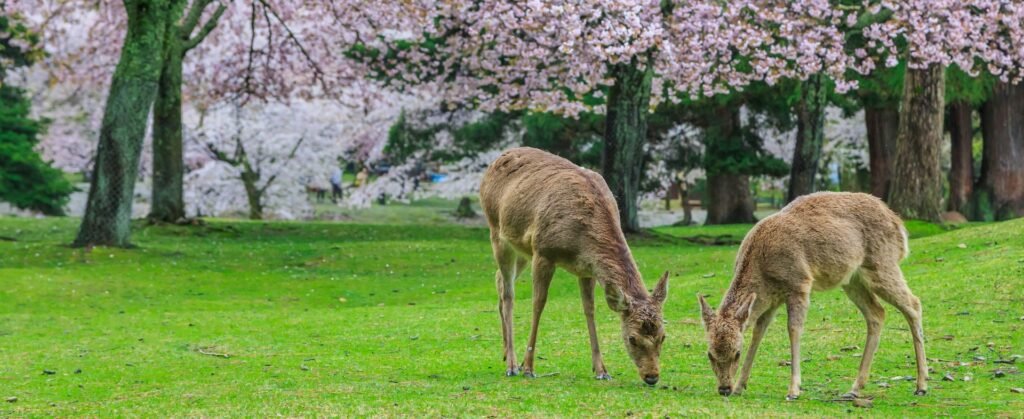
Nara, Japan’s first permanent capital since 710 AD, is a compact city brimming with history and charm. Famous for Todai-ji Temple’s massive Great Buddha and the bowing deer of Nara Park, it’s a UNESCO-rich gem easily reached from Kyoto or Osaka. The serene Kasuga-taisha Shrine, with its lantern-lined paths, and the quaint Naramachi district of traditional merchant homes offer a peaceful escape with a cultural punch—perfect for a day trip or more.
It helps keep this site running, and we appreciate your support!
Sightseeing
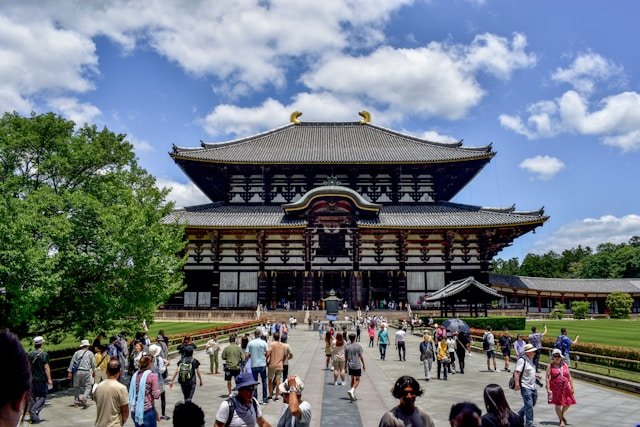
Todai-ji Temple
Step through the towering Nandaimon Gate, flanked by fierce Nio statues, and enter this UNESCO marvel from 752 AD, where the Great Buddha—a 15-meter bronze colossus—resides in the Daibutsuden, the world’s largest wooden building. Friendly deer roam the sprawling grounds, adding a playful vibe to the sacred setting. For a quirky twist, try squeezing through the “Buddha’s nostril” hole in a pillar, said to grant enlightenment. It’s an unmissable blend of spiritual grandeur and natural whimsy, offering a deep dive into Japan’s Buddhist heritage that’s as fun as it is profound.
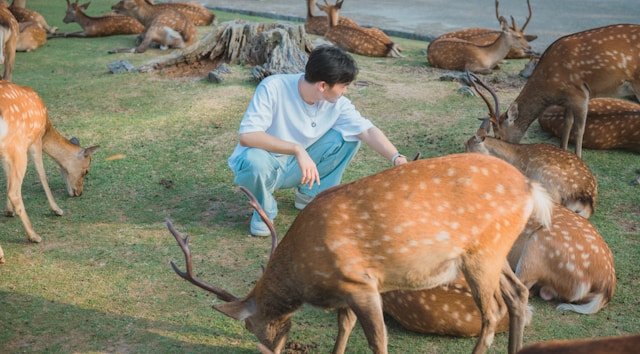
Nara Park
Established in 1880, this 660-hectare park teems with over 1,200 sacred deer that bow politely for shika senbei crackers, creating a one-of-a-kind experience. Stretching between Todai-ji and Kasuga-taisha, it’s a scenic hub perfect for leisurely walks, with tranquil ponds and wide lawns. Spring cherry blossoms or autumn’s fiery leaves elevate its beauty, drawing photographers and nature lovers alike. It’s a rare fusion of wildlife and culture, delivering a peaceful escape where you can unwind and snap some unforgettable deer selfies.
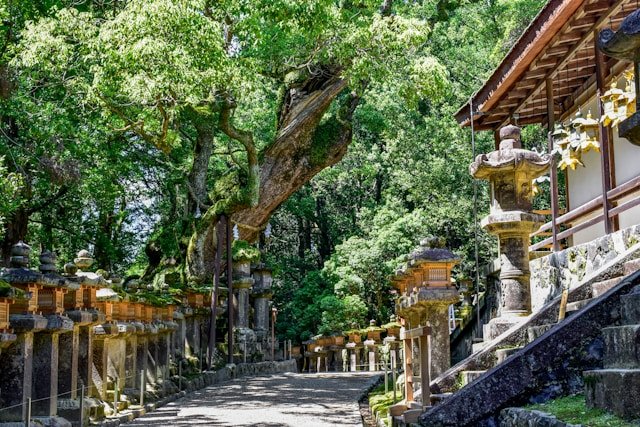
Kasuga-taisha Shrine
Since 768 AD, this Shinto shrine has stood as a protector of Nara, its vermilion pillars contrasting beautifully with thousands of lanterns—stone ones lining paths, bronze ones dangling from eaves, all gifts from devotees. A UNESCO site at Mount Mikasa’s forested base, it glows during the lantern-lighting festivals in February and August, a sight straight out of a fairytale. The primeval woods lend an air of mystery, while the inner sanctum’s intricate details captivate. It’s a serene testament to Japan’s spiritual traditions, ideal for stunning photos and quiet contemplation.
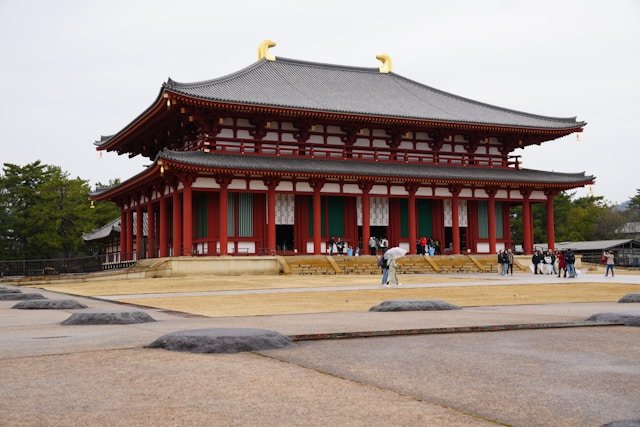
Kofuku-ji Temple
Built in 669 by the influential Fujiwara family, this Buddhist temple once sprawled across 175 buildings, though today its five-story pagoda—rebuilt in 1426—steals the spotlight as a Nara landmark. The three-story pagoda and Eastern Golden Hall still impress, while the nearby National Treasure Museum houses gems like the three-faced Ashura statue from the 8th century. Tucked near Nara Park, it offers a quieter, reflective stop compared to busier sites. It’s a compelling window into Japan’s storied past, perfect for those who love history with a side of architectural beauty.
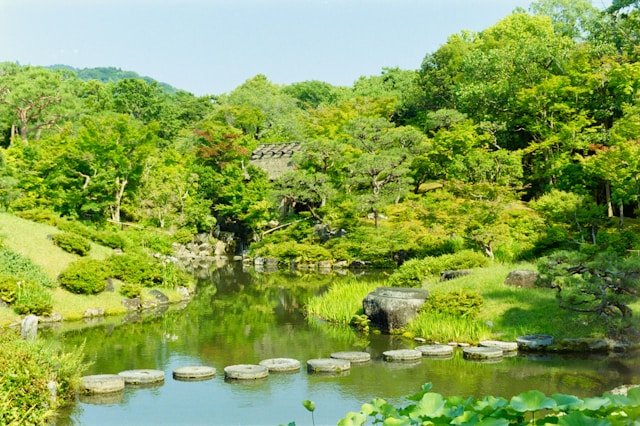
Isuien Garden
Divided into a 17th-century front section and an 1899 rear addition, this strolling garden masterfully “borrows” Mount Wakakusa as a backdrop, blending nature with meticulous design. Winding paths, serene ponds, and teahouses create a soothing retreat, with spring wisteria or autumn maples adding seasonal flair. A small museum displays pottery from Korea and China, offering a cultural bonus. Steps from Todai-ji, it’s a peaceful spot to sip matcha, unwind, and soak in Nara’s quieter, greener side after a temple-filled morning.

Mount Wakakusa
Rising 342 meters near Nara Park, this grassy hill promises sweeping views of Nara’s temples and forests after a brisk 20-30 minute climb—manageable but steep enough to feel rewarding. Spring cherry blossoms or the dramatic January Yamayaki festival, with its fire and fireworks, add seasonal thrills, while deer graze along the way. Entry’s free, making it a budget-friendly gem for active travelers or anyone after a scenic perch. Pack a camera and sturdy shoes for a refreshing, high-up perspective on the city.
Activities
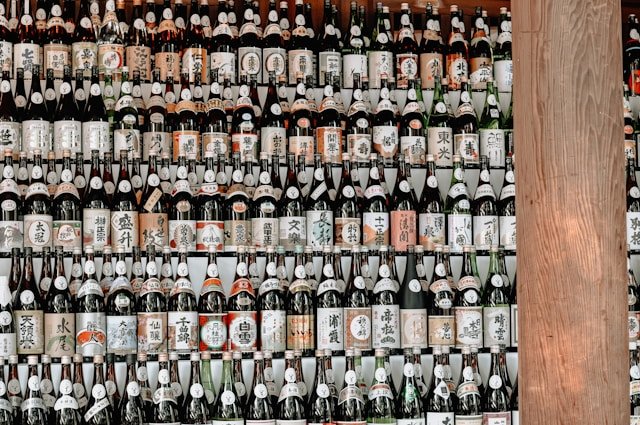
Harushika Sake Brewery
Dive into a sake tasting at Harushika Sake Brewery, a short walk from Nara Park, where for about $5 USD you can sample five distinct sakes plus a bonus pour, paired with local pickles. This fifth-generation brewery offers a cozy, casual vibe—no fancy tour needed, just 30 minutes of sipping and learning from English-friendly staff. It’s a budget-friendly way to taste Nara’s brewing heritage, and you can grab a bottle of their crisp, dry sake as a souvenir. Perfect for unwinding after a day of exploring, it’s a low-key gem that lets you connect with the city’s liquid history.
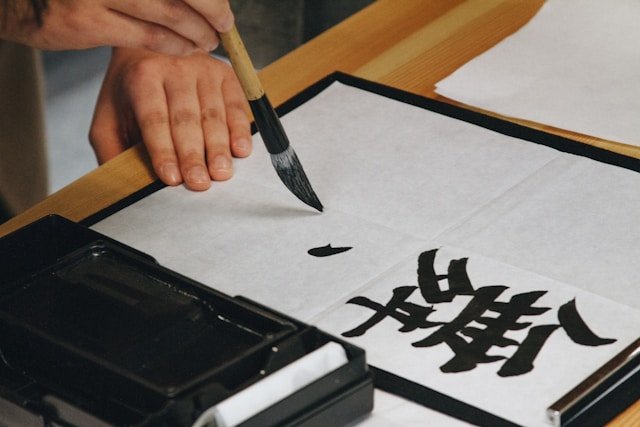
Calligraphy Lesson
Join a Japanese calligraphy lesson at the Nara Visitor Center & Inn, near Kofuku-ji Temple, where you can try your hand at shodo for free from 10 a.m. to 5 p.m. daily. Guided by multilingual staff, you’ll wield a brush to write kanji or your name, feeling the meditative flow of ink on paper. It’s a quick, immersive dip into a traditional art form—no prior skill needed—and you get to keep your creation. The center’s welcoming atmosphere makes it a fun, cultural pitstop that’s light on the wallet and heavy on authenticity.
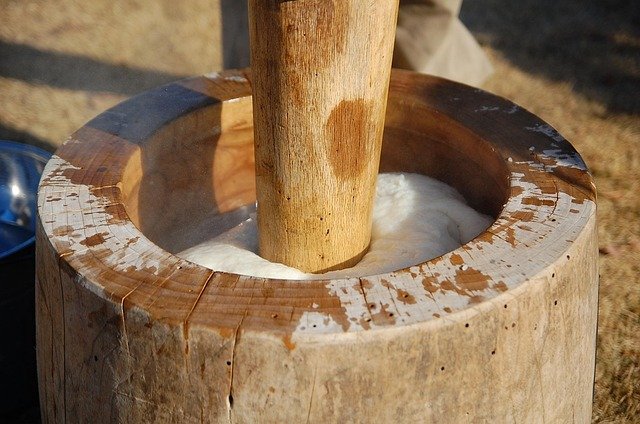
Mochi
Savor a mochi-pounding demonstration at Nakatanidou, a famous shop near Naramachi, where lightning-fast experts hammer rice into fresh, chewy mochi—sometimes hourly until 3 or 4 p.m. For about $3-5 USD, you can taste it warm, often filled with sweet red bean paste, right after the show. The high-energy performance is a spectacle, and the melt-in-your-mouth treat ties you to Nara’s culinary traditions. It’s a quick, delicious stop that’s as entertaining as it is tasty, though arrive early as they can sell out.

Bike Rental
Pedal through Nara’s quieter corners with a bike rental from spots like Kintetsu Nara Station for around $10 USD a day. Skip the main sights and cruise along the Yamanobe-no-Michi trail or Asuka’s rural paths, soaking in rice fields, small villages, and a slower pace. It’s an active, affordable way to explore beyond the deer and temples, with the freedom to stop at hidden cafes or scenic overlooks. Bring a map or app, and you’ve got a laid-back adventure that’s all your own.
Flights
Hotels
It’s a fantastic pick at around $40-60 USD per night, located just a 3-minute walk from JR Nara Station. For this price, you get modern, clean rooms with free Wi-Fi, plus access to an on-site natural hot spring bath—a rare treat at this rate. Recent guests rave about the fresh breakfast with baked bread and the unbeatable location near transport and Nara Park, making it a steal for the comfort and amenities packed into such an affordable package.
Priced at $65-90 USD per night, boasts an 8.8/10 rating and sits right next to JR Nara Station. For the cost, you get spacious, well-appointed rooms, a bathhouse, and a fitness center, with travelers praising the attentive service and 4-star quality. It’s a fantastic deal for those wanting a step up in comfort without a steep price hike, plus it’s perfectly positioned for sightseeing.
At $20-35 USD per night, is a modern guesthouse in Naramachi, just 4 minutes from JR Nara Station. It offers private Japanese- or Western-style rooms at hostel-like prices, with free Wi-Fi and a clean, efficient setup. Travelers love the welcoming vibe, affordable bike rentals, and easy access to Nara’s sights, making it an incredible deal for solo adventurers or couples seeking a traditional feel without the ryokan cost.
Starting at $40-60 USD per night, is a stylish option a 5-minute walk from JR Nara Station. Opened in 2017, it boasts air-conditioned rooms, free Wi-Fi, and a low-cost public bath, with guests highlighting the spacious, well-designed rooms—rare for Japan at this price. Its blend of modern flair, convenience, and extras like a laundromat make it a top choice for value-driven visitors who still want a fresh, comfortable stay.
Nara’s Hidden Bites: Five Dishes Beyond the Deer
Wrapped in persimmon leaves, this Nara classic turns sushi into a portable, rustic treat that’s been around since the Edo period. Fishermen originally used the leaves’ natural antibacterial properties to preserve mackerel or salmon atop vinegared rice, giving it a subtle tangy kick and faint fruity aroma. You’ll find it in bento boxes at shops like Hiraso near Nara Park—perfect for a picnic with the deer. It’s less about the raw fish flash of coastal sushi and more about savoring a simple, earthy bite that ties you to Nara’s inland traditions.
Steeped in Buddhist temple culture, this warm rice porridge brewed with roasted green tea offers a comforting, nutty twist on breakfast or a light meal. Monks at Todai-ji and other temples perfected it centuries ago as a humble, nourishing dish, and locals still swear by its soothing simplicity. Places like Chagayu Jaya near Kofuku-ji serve it steaming hot, sometimes with a sprinkle of salt or pickled plum for extra zing. It’s a cozy, low-key way to taste Nara’s spiritual side—ideal for chilly mornings or a quiet recharge.
Pickled in sake lees for up to three years, these crunchy veggies—think cucumbers, gourds, or watermelon rind—pack a punch of salty, boozy umami that’s pure Nara. Dating back to the 8th century, they were a preservation trick turned delicacy, often paired with rice or sake at spots like Morita in Naramachi. The fermentation gives them a sharp, funky edge that’s not for the faint-hearted but hooks adventurous eaters. It’s a bold taste of history, perfect for nibbling while exploring the old merchant streets.
Hailing from the Miwa region near Nara, these ultra-fine wheat noodles have been hand-stretched since the Nara period, thanks to the area’s pure water and wheat fields blessed by the Miwa Shrine. Served cold with a light soy-tsuyu dipping sauce in summer or warm in broth during winter, they’re silky and delicate—try them at Sanshu near Sakurai Station. Locals say the shrine’s deity inspired their creation, adding a divine twist to every slurp. It’s a refreshing, understated dish that’s all about texture and tradition.
Infused with mugwort, this chewy rice cake glows green and carries a grassy, herbal vibe unique to Nara’s countryside sweets. Pounded fresh at places like Nakatanidou in Naramachi, it’s often stuffed with sweet red bean paste and served warm, balancing earthy notes with a gentle sweetness. The yomogi plant’s supposed to boost stamina—handy after temple-hopping—and its vibrant color makes it Instagram bait. It’s a sticky, satisfying treat that roots you in Nara’s rural charm, especially if you catch a live mochi-making show.
Tips
Japan is largely a cash-based society, so bring some Japanese yen (JPY) with you. In Nara, ATMs at 7-11, FamilyMart, or Japan Post are reliable for withdrawing cash with international cards—just check for foreign transaction fees (a Wise card can save you on those). Expect to spend around ¥3,000-5,000 per day on food and transport if you’re budget-conscious, with meals like kakinoha-zushi costing ¥800-1,200 and deer crackers at ¥200 a pack. Credit cards work at bigger hotels and some restaurants, but small shops and stalls near Nara Park often only take cash. For tax-free shopping (over ¥5,001 at participating stores), carry your passport—great for souvenirs like sake or crafts.
Nara’s a breeze to reach from Kansai hubs like Osaka or Kyoto, both under an hour away. From Kansai International Airport (KIX), take the JR Haruka Express to Tennoji, then a JR Yamatoji train to Nara (¥2,180, 70-90 minutes), or grab a limousine bus straight to Nara for ¥2,050—ideal with luggage. The JR Nara Line (¥720, 45 minutes) or Kintetsu Nara Line (¥760, 35-50 minutes) connect from Kyoto; Kintetsu’s faster if you skip the JR Pass. In Nara, most sights like Todai-ji are walkable from Kintetsu Nara Station, but the Nara Bus Pass (¥600 for 1 day) covers outlying spots like Horyu-ji. Renting a bike for ¥1,000/day is another fun option—just watch for deer poop!
Timing
Pack comfy walking shoes—Nara’s all about strolling, and deer trails can get messy. Free Wi-Fi’s spotty outside hotels, so consider a pocket Wi-Fi or SIM card from the airport. English signage is decent near tourist spots, but a translation app like Google Translate helps with menus or chats with locals. Lastly, deer are everywhere—keep food hidden unless you’re ready to share! Nara’s compact, so even a day trip works, but an overnight stay lets you catch the early calm or golden hour glow.
